|
|
|
Sort Order |
|
|
|
Items / Page
|
|
|
|
|
|
|
| Srl | Item |
| 1 |
ID:
141162
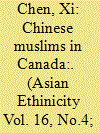

|
|
|
|
|
| Summary/Abstract |
To date, there has been little to no literature examining Chinese Muslim immigrants to Western nations. Recognizing the dearth of such literature, this research presents what appears to be the first-ever descriptive statistical picture of Chinese Muslims migrating to and residing in Canada. By examining how this immigrant population compares to and fares against non-Muslim Chinese and non-Chinese Muslims in Canada with Canadian census data in 1991 and 2001, the research provides preliminary analysis on the saliency of originating Chinese Muslim ethnicity in immigration outcomes. The current findings suggest that with the intersection of cultural and religious identities, Chinese Muslim may experience a different assimilation process compared to non-Muslim Chinese and non-Chinese Muslims.
|
|
|
|
|
|
|
|
|
|
|
|
|
|
|
|
| 2 |
ID:
141158
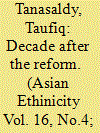

|
|
|
|
|
| Summary/Abstract |
Political reform after the departure of President Soeharto’s New Order (1966–1998) provided opportunities for previously oppressed social groups to express their concerns and to demand fair recognition. The results of this newly found freedom have been quite immediately visible in Jakarta, where social and political institutions spearheaded by Chinese originally sprouted. In the regions, political participation of ethnic Chinese has also grown; significantly in those regions with a large Chinese population. In West Kalimantan, the number of Chinese being elected to local parliaments in some regions has doubled. They have also contested numerous direct local executive elections since 2003 and have been successful in winning four posts: a mayor, a district head, a deputy district head, and a deputy governor. By looking at the case of West Kalimantan, this article will examine the factors behind the growth in Chinese political activism, the factors contributing to the success of Chinese candidates in elections, how the Chinese have influenced local and provincial politics, and the challenges they are facing.
|
|
|
|
|
|
|
|
|
|
|
|
|
|
|
|
| 3 |
ID:
141164
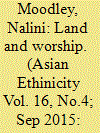

|
|
|
|
|
| Summary/Abstract |
This article, drawn from my doctoral study, focuses on the landscape paintings of two South African graduates of the former Indian institution, the University of Durban-Westville. The work is analysed through the lens of Hindu philosophy and Hindu ritualistic practice which views the earth as fundamental for survival and intrinsically linked to the cosmic order. This article presents the Hindu attachment to the land seen in the expansive imagery of Hindu deities located within serene landscapes resplendent in its attention to mythological and symbolic details. This attachment positions Hinduism as a guide to the exploration of the paintings. This article locates the work within the complex historical base of Indians in South Africa, and the impact it had on contemporary artists of Indian ancestry. While their art production addresses their conflating Indian/South Africanness, their paintings can be viewed as a veiled historiography of the Indian presence in South Africa.
|
|
|
|
|
|
|
|
|
|
|
|
|
|
|
|
| 4 |
ID:
141163
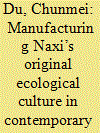

|
|
|
|
|
| Summary/Abstract |
For over a decade, original ecological (yuanshengtai原生态) has contested ethnic (minzu) as an influential framework in representing minority folk culture in Chinese official and popular media. This article explores the ideological implications of such a shift in the context of state-minority relationships. By examining Han elites’ invention of the neologism and Naxi elites’ adaptations, I argue that YST transforms local ethnic categories into a transethnic, translocal, and transnational concept, and therefore allows both the nation state and the minority groups to promote their own versions of ethnic identities. Compared to the antagonistic model between state domination and minority resistance, YST reflects a shift from minority political self-determination to cultural self-representation in the drastically changing global environments.
|
|
|
|
|
|
|
|
|
|
|
|
|
|
|
|
| 5 |
ID:
141161
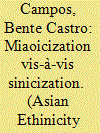

|
|
|
|
|
| Summary/Abstract |
This article studies the Miao classification as an example to examine the minzu shibie project initiated by the Chinese Communist Party after 1949. The Miao classification that originates with the minzu shibie project can be defined as a process of miaoicization; however, it is not a unified Miao group (as projected by the classification team) that has emerged but rather one dominant Miao subgroup that defines the official Miao category in contemporary China. At the moment the most dominant Miao subgroup is the Hmu group in Southeast Guizhou. The overemphasis of Hmu sub-culture to represent all the Miao of China is related to the fact that over the last decades many important leaders in Guizhou have been Hmu. While all Hmu are sinicized to a certain extent, it seems that the Hmu at the bottom of the socioeconomic scale are most likely to be sinicized and to amalgamate with the Han majority.
|
|
|
|
|
|
|
|
|
|
|
|
|
|
|
|
| 6 |
ID:
141156


|
|
|
|
|
| Summary/Abstract |
This study explores the Terengganu and Kelantan Peranakan Chinese foodways with special reference to two types of foods: daily and ancestral prayer foods. The principal focus is to illustrate the negotiation of identity through foodways as well as internal contradictions arising from this process of identity negotiation. These two groups of Peranakan Chinese are largely the product of acculturation by the local Malays through socio-cultural interactions, though the Kelantan Peranakan Chinese are also acculturated by the local Thai community. Their daily and ancestral prayer foods display contrasting identities that stem from the negotiating of their acculturated and primordial identities. The former displays a strong local cultural influence, while the latter displays a strong Chinese cultural influence. However, despite the pervasive influence of localisation in their daily foods, elements of hybridisation are visible in some occasionally prepared food items. Meanwhile, localised and hybrid food items are included in their ancestral prayer foods, which are supposed to express their primordial Chinese identity. These internal contractions illustrate the complexity of the negotiation of identity through foodways within a cross-cultural context.
|
|
|
|
|
|
|
|
|
|
|
|
|
|
|
|
| 7 |
ID:
141160
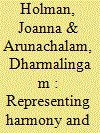

|
|
|
|
|
| Summary/Abstract |
This article investigates multiculturalism and ethnicity in Singapore. The study conducted a qualitative content analysis of articles appearing in the Straits Times newspaper over a three month period in 2010. It was found that multicultural harmony tended to be represented as unnatural, fragile, and requiring government intervention. There also tended to be a focus on distinct and fixed ethnic identities, reflecting an essentialist understanding of ethnicity. These beliefs about the nature of multiculturalism and ethnic identity were reflected in the coverage of three major social issues. These were the perceived needs to maintain the ethnic composition of Singapore’s population, efforts to prevent cultural corruption or neglect, and concerns about the impact of immigration on multicultural harmony.
|
|
|
|
|
|
|
|
|
|
|
|
|
|
|
|
| 8 |
ID:
141159


|
|
|
|
|
| Summary/Abstract |
Using the concepts of ‘social capital deficit’ and ‘return deficit’, this study considers the social network aspects of social disadvantage among Malays in Singapore, as compared to Singaporean Chinese. Analysing a 2005 representative survey, we find Malays have less social capital than Chinese, a social capital deficit partly explained by their lower educational attainment. We find no return deficit in earnings: that is, every additional unit of social capital increases earnings equally for Chinese and Malays. However, we find return deficits in education: every additional unit of social capital (e.g. ties to educated parents) increases educational attainment more for Chinese than Malays. In all, this study offers a social capital explanation for Malay ‘plight’, complementing the more conventional explanations of human and economic capital.
|
|
|
|
|
|
|
|
|
|
|
|
|
|
|
|
| 9 |
ID:
141157
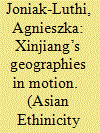

|
|
|
|
|
| Summary/Abstract |
At the same time it asserts that Uyghur and Han do not establish distinct spatial relationships just because of their ethnicity, but also to enhance ethnic solidarity and boundaries vis-à-vis the other. This essay also demonstrates that places are historically contingent, and discusses the ways in which the influx of temporary Han migrants and settlers – and Han capital – has generated new layers of spatial meaning and new power differentials.
|
|
|
|
|
|
|
|
|
|
|
|
|
|
|
|
|
|
|
|
|